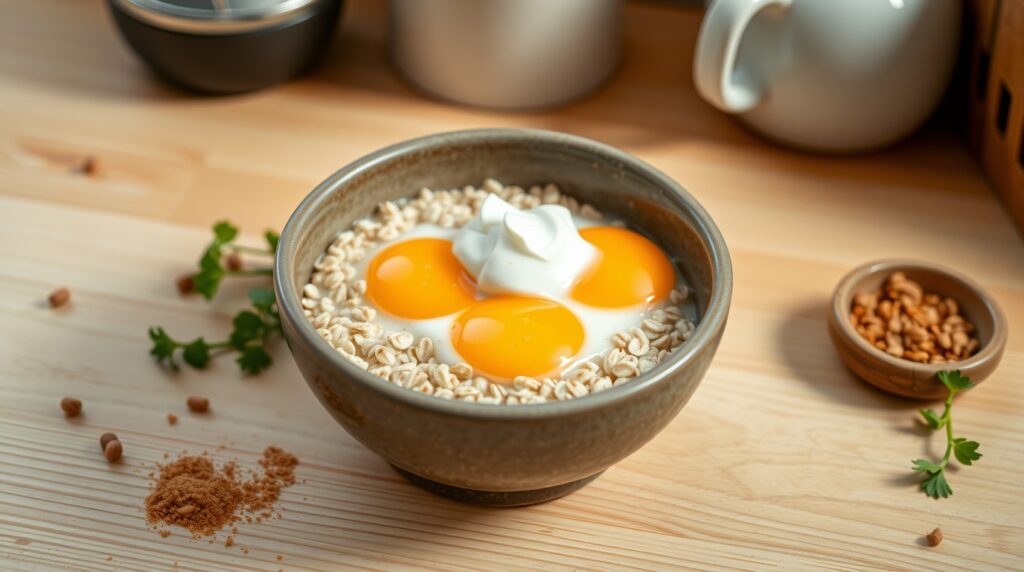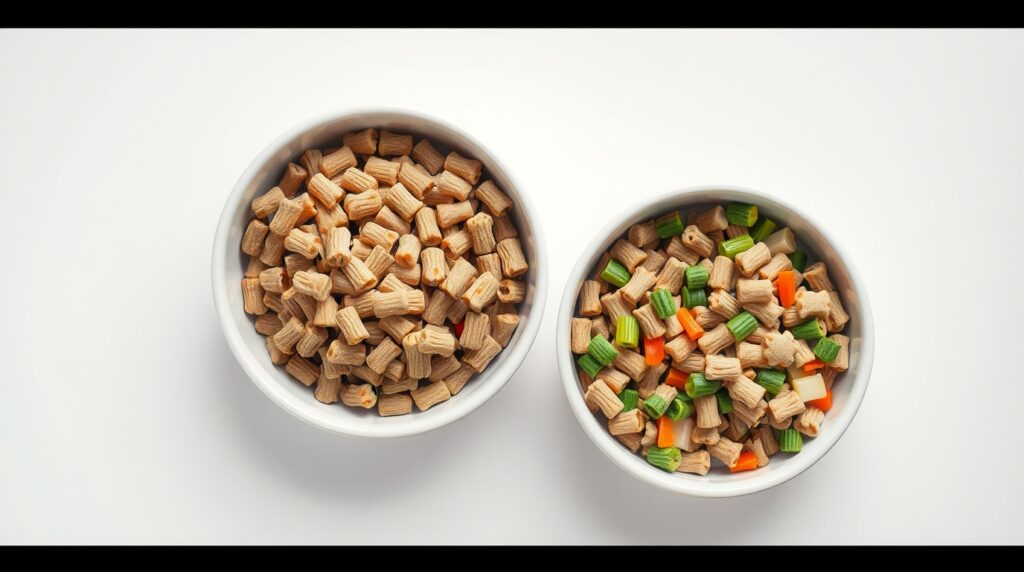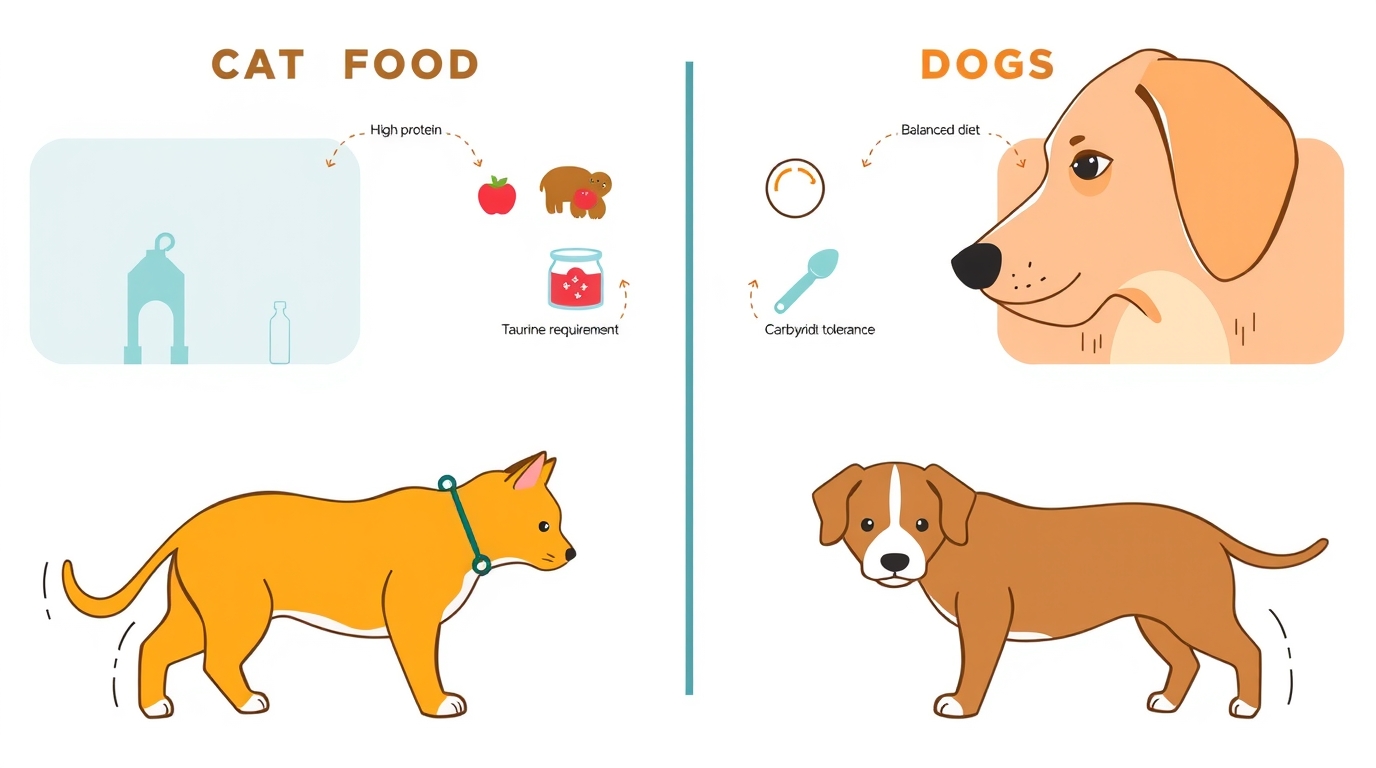If you’re a pet parent, you’ve probably wondered, “Is cat food really that different from dog food?”
The answer is a big YES. Cats and dogs have completely different nutritional needs, and feeding the wrong food can harm their health over time. This article breaks down all the major differences, complete with a cat food vs dog food comparison chart to help you understand what’s right for your furry friend.
What Makes Cat Food Different from Dog Food?

Carnivores vs Omnivores
Cats are obligate carnivores, meaning they need meat to survive.
Dogs are omnivores, meaning they can thrive on a mix of meat, grains, and vegetables.
Key Nutritional Differences
Protein Levels
Cat food contains higher protein levels, as protein is the primary source of energy for cats.
Fat Content
Cat food often contains higher fat, giving it a richer taste.
Vitamins & Minerals
Cats need more taurine, vitamin A, vitamin B12, and arachidonic acid, which dog food cannot provide in adequate amounts.
Essential Nutrients Required by Cats
Taurine
A must-have amino acid that supports vision, heart health, and digestion.
Arachidonic Acid
Cats cannot produce this fatty acid on their own.
High Protein Requirement
Cats need twice the protein that dogs do.
Vitamin A & B12
Crucial for immunity, vision, and metabolism.
Essential Nutrients Required by Dogs
Balanced Protein
Dogs do not need extremely high protein levels.
Healthy Fats
Fat supports energy and skin health, but in moderate amounts.
Carbohydrates
Dogs can digest grains and carbs easily.
Vitamin & Mineral Needs
Dogs produce some nutrients naturally—cats cannot.
Cat Food vs Dog Food Chart (Side-by-Side Comparison)

Detailed Comparison Table
| Nutrients/Aspect | Cat Food | Dog Food |
|---|---|---|
| Protein | Very high (30–40%+) | Moderate (18–25%) |
| Fat | High | Moderate |
| Carbohydrates | Low | Higher |
| Taurine | Added | Not required |
| Vitamin A | Preformed | Often plant-based |
| Texture | Strong aroma, richer taste | Mild aroma |
| Designed For | Carnivores | Omnivores |
| Daily Suitability | Only for cats | Only for dogs |
Why Cats Should Not Eat Dog Food
Lack of Taurine
Can lead to heart issues and blindness.
Poor Protein Levels
Dog food cannot meet a cat’s high protein demand.
Risk of Malnutrition
Long-term consumption can damage organs.
Why Dogs Should Not Eat Cat Food
Too Much Protein/Fat
Dog digestive systems cannot handle excess.
Digestive Issues
May cause vomiting and diarrhea.
Risk of Obesity & Pancreatitis
Cat food is calorie-dense and harmful for dogs long term.
Special Cases – Can It Ever Be Safe?
Emergency Feeding
Short-term or accidental feeding is usually fine.
Short-Term vs Long-Term
Long-term feeding is unsafe for both species.
How to Choose the Right Food for Your Pet
Reading Ingredient Labels
Look for whole proteins, fewer fillers, and natural ingredients.
Checking AAFCO Certifications
Ensures the food meets minimum nutritional standards.
Age-Based Nutritional Needs
- Puppies/kittens need specialized formulas
- Senior pets need fewer calories
Homemade Food vs Commercial Food
Which Is Better?
Commercial food is nutritionally complete.
Safety Concerns
Homemade food often lacks essential nutrients.
Vet Recommendations
Always consult a vet before switching to homemade diets.
Final Cat Food vs Dog Food Chart for Quick Understanding
| Category | Cats | Dogs |
|---|---|---|
| Diet Type | Obligate carnivores | Omnivores |
| Protein Needs | Very high | Moderate |
| Taurine Required? | Yes | No |
| Safe to Share Food? | No | No |
Conclusion
Both cats and dogs need species-specific diets to stay healthy. While it may seem harmless to let your dog nibble on cat kibble—or vice versa—these foods are specially formulated for the unique nutritional needs of each species. Always choose food that matches your pet’s biological requirements to ensure a long, healthy, and active life.
FAQs
1. Is it okay for dogs to eat cat food occasionally?
Yes, but only occasionally. Long-term consumption can cause health issues.
2. What happens if a cat eats dog food every day?
It can lead to nutrient deficiencies, heart problems, and even blindness.
3. Why is taurine important for cats?
It supports vision, digestion, heart function, and immune health.
4. Can puppies and kittens eat the same food?
No. Both require age-specific formulas for proper growth.
5. How to safely switch pet food?
Transition gradually over 7–10 days by mixing old and new food.
Also Read:


